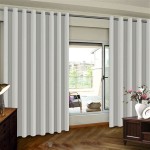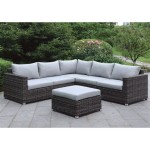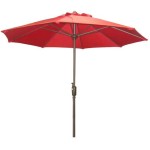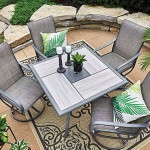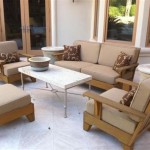Patio Furniture in the Living Room: A Design Consideration
The incorporation of patio furniture into interior spaces, specifically the living room, represents a departure from traditional design norms. This trend, driven by factors such as cost-effectiveness, aesthetic preferences, and a desire for durable and low-maintenance furnishings, necessitates a careful evaluation of the suitability and integration of such pieces within the context of indoor living.
While traditionally relegated to outdoor environments, patio furniture is increasingly being considered for use within the more sheltered confines of the living room. This shift requires an understanding of the inherent differences between outdoor and indoor furniture, as well as the potential benefits and drawbacks of blurring these lines. The subsequent integration demands a consideration of material properties, stylistic compatibility, and the overall impact on the perceived ambiance of the room.
This article will explore the key considerations involved in successfully incorporating patio furniture into a living room setting. It will analyze the factors that contribute to the feasibility and aesthetic appeal of this design choice, focusing on material selection, stylistic considerations, and practical implications for indoor use.
Material Considerations for Indoor Use
The selection of appropriate materials is paramount when considering patio furniture for indoor application. Outdoor furniture is typically constructed from materials designed to withstand the elements, including prolonged exposure to sunlight, moisture, and temperature fluctuations. While these attributes contribute to durability, they may not always align with the aesthetic or comfort requirements of an indoor living space.
Rattan and wicker, commonly used in patio furniture, offer a natural and textured aesthetic. However, it's crucial to differentiate between natural and synthetic rattan. Natural rattan, while visually appealing, may be susceptible to damage from dryness and fluctuations in indoor humidity levels. Regular conditioning might be necessary to prevent cracking or splitting. Synthetic rattan, crafted from durable polymers, offers greater resilience to indoor conditions and requires less maintenance. It closely mimics the appearance of natural rattan while providing increased longevity.
Metal frames, frequently found in patio furniture, are generally robust and long-lasting. Aluminum is a popular choice due to its lightweight nature and resistance to rust. However, bare metal can feel cold and industrial in an indoor setting. Powder coating or the addition of cushions and upholstery can soften the appearance and enhance comfort. Steel, while stronger than aluminum, is prone to rust if not properly treated. Stainless steel is the most corrosion-resistant option but also the most expensive.
Wood, particularly teak and cedar, is often used in high-end patio furniture. These woods are prized for their natural resistance to decay and insects. However, regardless of their inherent properties, wooden furniture intended for indoor use should be treated with a sealant to prevent drying and cracking. Proper sanding and finishing techniques can also enhance the wood's natural beauty and create a more refined aesthetic for the living room.
Fabric choices are also critical. Outdoor fabrics are typically designed to be water-resistant, fade-resistant, and mildew-resistant. While durability is advantageous, the texture and feel of outdoor fabrics may not be as comfortable or luxurious as those specifically designed for indoor upholstery. Sunbrella fabric, a common choice for patio furniture, offers excellent durability and stain resistance, but its texture can be somewhat rougher than indoor alternatives like velvet, linen, or cotton. The decision hinges on balancing durability with desired comfort levels.
Stylistic Integration and Design Principles
The successful integration of patio furniture into a living room requires careful consideration of stylistic compatibility. The existing décor, color palette, and overall design theme of the room should inform the selection of patio furniture to ensure a cohesive and visually appealing outcome. A mismatch in styles can lead to a jarring and unharmonious aesthetic.
A bohemian or eclectic living room, for example, might readily accommodate rattan or wicker patio furniture. The natural textures and organic shapes of these materials complement the relaxed and informal atmosphere often associated with these design styles. However, in a more formal or traditional living room, the use of patio furniture might require a more nuanced approach.
Metal-framed patio furniture can be successfully incorporated into modern or industrial-style living rooms. The clean lines and minimalist aesthetic of metal can complement the sleek and uncluttered look often found in these spaces. However, it is important to soften the metallic appearance with appropriate cushions and throws to prevent the room from feeling cold or sterile. The choice of metal finish, such as brushed nickel or matte black, can also significantly impact the overall aesthetic.
The scale of the furniture is another important consideration. Patio furniture is often designed to be smaller and more lightweight than traditional living room furniture. This can be advantageous in smaller living spaces where space is at a premium. However, in larger living rooms, smaller patio furniture pieces might appear dwarfed and out of proportion. It is essential to carefully measure the available space and select furniture that is appropriately sized to create a balanced and harmonious composition.
The use of accessories can also play a crucial role in integrating patio furniture into a living room. Throw pillows, blankets, rugs, and artwork can help to soften the look of more rugged patio furniture and tie it into the overall design scheme. Selecting accessories in complementary colors and textures can create a sense of cohesion and visual harmony.
Practical Implications for Indoor Living
Beyond aesthetics, the practical implications of using patio furniture in a living room must be carefully considered. Outdoor furniture is designed to withstand wear and tear from environmental factors, but its suitability for the daily use and specific demands of indoor living should be evaluated.
Comfort is a primary concern. While durable, some patio furniture designs may prioritize weather resistance over ergonomic comfort. The addition of plush cushions and supportive padding can significantly improve the comfort level. It's essential to consider the seat height, back support, and overall ergonomics of the furniture to ensure it is comfortable for extended periods of sitting and relaxation.
Maintenance requirements should also be factored in. Although patio furniture is often designed to be low-maintenance, it may still require regular cleaning to prevent the build-up of dust and dirt. The chosen materials should be easy to clean and resistant to stains. Fabrics should be chosen with indoor living in mind, considering factors like stain resistance and ease of cleaning.
Floor protection is another important consideration. The legs of patio furniture may not be designed to protect delicate indoor flooring surfaces. The addition of felt pads or other protective measures can prevent scratches and damage to hardwood floors, tile, or carpets. The weight distribution of the furniture should also be considered, particularly on softer flooring surfaces.
Finally, the potential for off-gassing should be taken into account, particularly with synthetic materials. Some patio furniture, especially those made from plastics, may release volatile organic compounds (VOCs) into the air. Choosing furniture made from low-VOC materials or allowing for adequate ventilation can mitigate this issue. Prior research on the materials used in the furniture and the manufacturer's commitment to environmental standards is advisable.
In conclusion, the decision to incorporate patio furniture into a living room involves a multifaceted assessment of material properties, stylistic preferences, and practical considerations. A thoughtful approach, guided by an understanding of both the benefits and potential drawbacks, can result in a unique and aesthetically pleasing living space.

Home Tip Using Outdoor Furniture Indoors

Home Tip Using Outdoor Furniture Indoors Indoor Patio Used

Key Measurements For Planning Your Outdoor Furniture Layout

Hot Trend Using Outdoor Furniture Inside Your Home

5 Ways To Use Your Outdoor Furniture Indoors Early Settler S Home Life

3 Reasons To Use Outdoor Furniture Indoors On The Pulse

Reasons For Using Outdoor Furniture Indoors Homes Re Imagined Used Wicker Indoor

5 Ways To Use Your Outdoor Furniture Indoors Early Settler S Home Life

Outdoor Collections Tommy Bahama Furniture

Fun And Functional Outdoor Furniture Ideas Forbes Home


